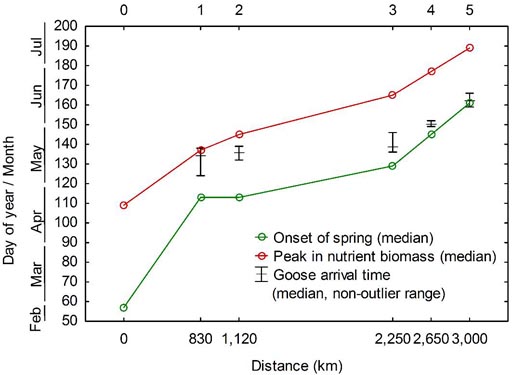Dr. Yali Si tested and refined the green wave hypothesis describing bird migration strategy in Scientific Reports
Dr. Yali Si has recently published a research paper entitled “Do Arctic breeding geese track or overtake a green wave during spring migration?” She found that Arctic breeding geese do not track a green wave (interpreted as either the onset of spring or the peak in nutrient biomass). Rather, they arrive at the southernmost stopover site around the peak in nutrient biomass, and gradually overtake the green wave to match their arrival at the breeding site with the local onset of spring. She collaborated with Prof. Peng Gong and Dr. Qinchuan Xin from the Center for Earth System Science, Porf. Prins and Dr. De Boer from Wageningen University, and Prof. Ydenberg from Simon Fraser University.
Geese breeding in the Arctic have to do so in a short time-window while having sufficient body reserves. Hence, arrival time and body condition upon arrival largely influence breeding success. The green wave hypothesis posits that geese track a successively delayed spring flush of plant development on the way to their breeding sites. The green wave has been interpreted as representing either the onset of spring or the peak in nutrient biomass. However, geese tend to adopt a partial capital breeding strategy and might overtake the green wave to accomplish a timely arrival on the breeding site. To test the green wave hypothesis, they linked the satellite-derived onset of spring and peak in nutrient biomass with the stopover schedule of individual Barnacle Geese.

Figure 1. Dates of the onset of spring and the peak in nutrient biomass at each site against the flight distances. Sites include wintering site (0), stopover sites (1–4), and the breeding site (5). Error bars indicate the median and range of the arrival time of 19 female Barnacle Geese. Geese overtake green wave by arriving at the southern stopover site at the peak in nutrient biomass and arriving at the breeding site at the local onset of spring.
They demonstrated that Arctic breeding geese gradually overtake the green wave by arriving at the southernmost stopover site at a high plant development level (close to the peak in nutrient biomass), following the successively lower level of plant development as migration progresses, and matching their arrival at the breeding site with the local onset of spring, which facilitates gosling rearing later in the season. Their approach for estimating plant development stages is critical in testing the migration strategies of migratory herbivores and further predicting their spatiotemporal migration patterns. It also facilitates modelling the transmission of bird-borne infectious diseases using climate-driven changes in plant phenology.
This research was supported by the National Natural Science Foundation of China (No.41471347) and Tsinghua University (No.2012Z02287).